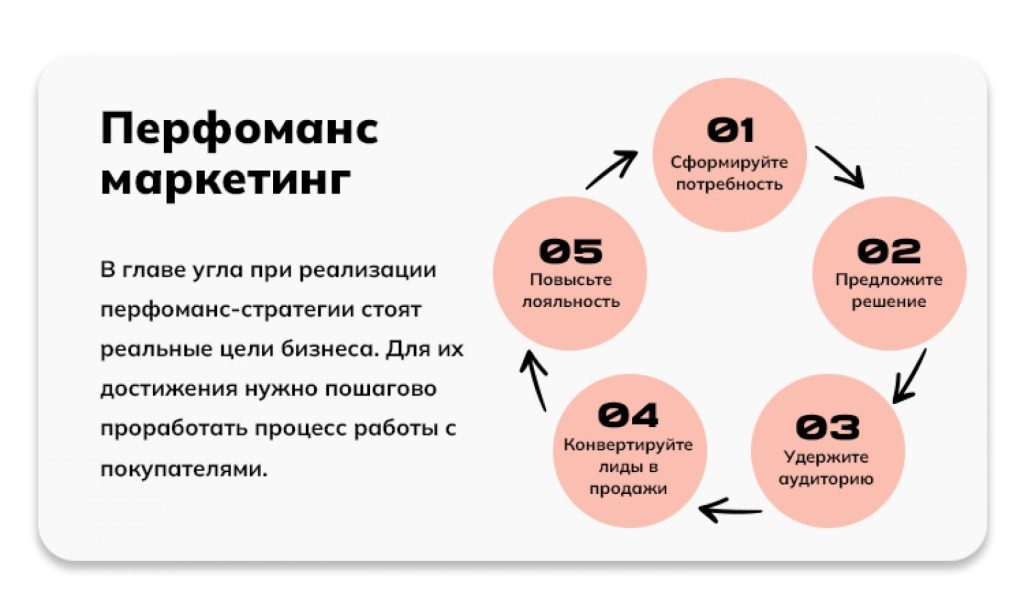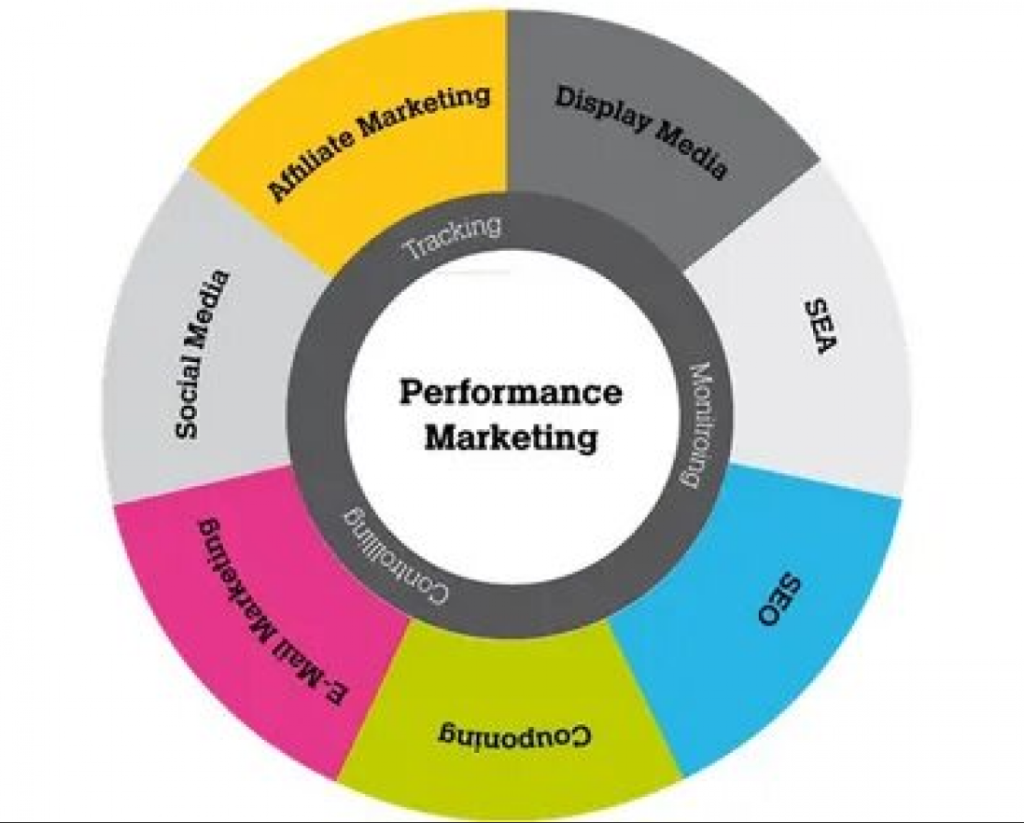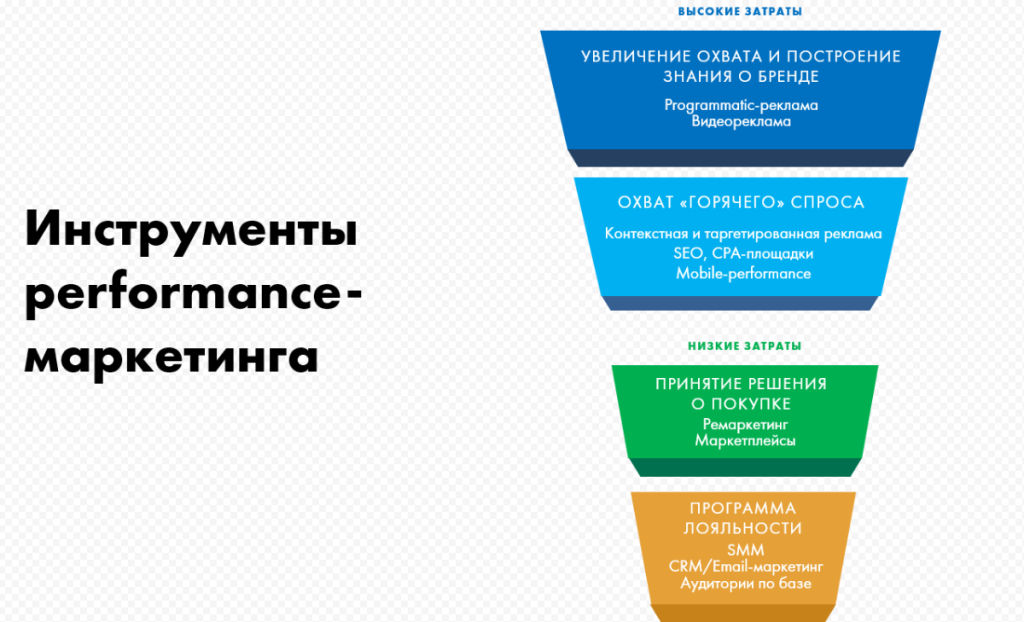What is Performance Marketing and How Does it Work?
Performance marketing is a promotion strategy aimed at achieving measurable financial results (KPIs) in a short period of time. It's a must-master approach for anyone looking to avoid wasteful spending and identify the most effective budget allocations. Performance marketing differs from other approaches in that it doesn't rely on abstract metrics but focuses on specific sales. It's particularly useful during periods of declining profits and economic downturns. Furthermore, this approach is effective when there's already existing demand from your audience.
Performance marketing requires significant investment. It's worthwhile for companies with a marketing budget of 200,000 rubles per month or more. However, even if your budget is limited, you can use the basic principles of performance marketing. Track the costs of each advertising channel. If the effectiveness of one tool declines, reallocate funds to more effective areas.
Features of Performance Marketing:
Measurability of the effectiveness of the channels used.
Evaluate business metrics such as customer acquisition cost (CPA) and return on investment (ROI).
The ability to influence indicators and adjust strategy in real time.
Synchronize various marketing tools, such as SEO, SMM, email marketing, and display advertising, to achieve maximum results.
Performance marketing campaigns measure and track their effectiveness using referral links, coupon codes, and individual phone numbers. This approach requires setup and testing, as well as developing an effective strategy and using a user-friendly and fast platform. However, all the effort pays off thanks to a high return on investment (ROI) and the ability to easily determine campaign success.

How to Use Performance Marketing Effectively?
To understand how performance marketing works, it's important to understand its fundamental components. One of the key components is in-depth data analytics. At the initial stage, it's necessary to analyze the company's business metrics, study competitors and the market, and consider the advantages and disadvantages of products or services. It's also crucial to study the target audience, top queries in the chosen niche, the semantic core, and the effectiveness of all traffic sources. In-depth analytics should be present at every stage of the process, as it allows for monitoring the effectiveness of advertising spend.
Another important step is setting goals. Defining a specific, measurable, and time-bound objective is the starting point for campaign development. The goal determines the strategy, timeline, budget, and choice of advertising tools.
Next comes the development of a comprehensive strategy, including the selection of the most effective advertising tools and channels in line with the stated goals. Regular audits allow for the adjustment of effective methods and the replacement of unprofitable ones with new ones that deliver predictable results.
A key aspect of performance marketing is managing advertising channels. It's important not only to track the number of requests but also to determine the extent to which these requests are linked to specific advertising channels and their quality. End-to-end analytics allows you to identify the budget spent on channel development and the revenue generated by the company. Performance analysis helps track consumer journeys through the sales funnel, determine the average order value of each channel, and determine profitability over the reporting period.
Performance marketing utilizes a variety of tools, including contextual advertising, targeted social media advertising, marketplaces, email marketing, native advertising, mobile marketing, remarketing, and affiliate programs. All of these tools work together to achieve key business goals.
Performance marketing allows you to effectively increase your business's lead volume by analyzing data, setting specific goals, building a comprehensive strategy, and managing advertising channels. Selecting the optimal advertising tools and continuous analytics will help you achieve success in your marketing efforts and improve your business's performance.

An example of performance marketing in action.
Let's say your company is a website development company and you want to increase your sales by driving more targeted traffic to your site.
Step 1. Depending on the specifics of your business, we select and coordinate media tools and platforms visited by potential clients.
Stage 2. Using contextual and targeted advertising on social media, we attract visitors to your website, who then return through regular advertising channels, leading to an increase in inquiries. Previously attracted audiences also return to the site through branded SEO queries. Furthermore, visitors actively subscribe to email newsletters. Through email marketing, we increase loyalty and sales.
Step 3: We use dynamic retargeting and offer promotions to users who have already left your site.
Stage 4. We focus on repeat sales. Once acquired, users can become loyal customers, and we motivate them to make repeat orders using push notifications, social media targeting, and triggered email campaigns. We integrate all advertising tools into a single system and build user engagement to improve conversion.
Therefore, using effective marketing allows you to increase the volume of orders for your business by attracting targeted traffic to your website and retaining visitors, which ultimately leads to increased sales and growth of your business.
5 Metrics for Evaluating Performance Marketing Effectiveness
Unique visitors
One of the key performance marketing metrics is the number of unique visitors to your platform or website. Unique visitors indicate how successfully your marketing efforts are attracting new audiences. This metric can be measured using analytics tools and compared to previous periods or your competitors' metrics.
Qualified leads
A key performance marketing metric is the number of qualified leads generated by marketing campaigns. Qualified leads are potential customers who have expressed interest in your products or services and who match your target audience. This metric helps evaluate the effectiveness of your customer acquisition and conversion strategies.
SQL (Sales Qualified Leads)
SQL are qualified leads who are ready to close a deal and collaborate with your company. They have completed certain stages of the sales funnel and are ready to make a purchasing decision. This metric helps measure the effectiveness of your marketing strategy in attracting high-quality prospects, which your sales team then follows up with.
Closing Rate
The close rate is a metric that reflects the success of your business and your ability to convert leads into actual deals. It's calculated based on various factors, such as lead qualification, offer quality, company reputation, and competitive pricing. A high close rate indicates the appeal of your offer to clients and the skills of your sales team in effectively selling.
MRR (Managed Recurring Revenue)
MRR is a measure of recurring revenue, typically calculated as an average monthly value. It includes several factors, including new MRR (additional revenue from new customers), expanded MRR (additional revenue from existing customers, such as upgrading to a higher plan), and lost MRR (revenue lost due to customer churn). This metric helps you assess the stability and growth of your business.
Analyzing these metrics allows you to evaluate the effectiveness of your performance marketing efforts and take steps to improve them. Regular monitoring and analysis will help you optimize your marketing strategy and increase lead volume for your business.

Modern trends
As technology advances, the range of opportunities for reaching potential consumers expands. Future customer communications will be directly dependent on innovative offerings. New ways of delivering information to users will likely emerge in the near future, complementing existing channels.
Today the main ones are:
- Voice search.
- Integrated products in social networks.
- Video marketing.
- VR and AR.
- Interactive content.
- Chatbots and messengers.
- Artificial intelligence, automation of advertising purchasing.
- Personalized marketing.
- Influencers.
- Geomarketing.
- UGC content.
- Loading acceleration: PWA, AMP, Turbo.
Advantages
However, no one is suggesting using all existing technologies simultaneously. Such an approach would not be justified in terms of efficient budget spending and optimal impact on the target audience. It is important to select the most effective channels to achieve your promotional goals with minimal costs.
Every business faces the challenge of increasing sales and profits. To achieve this, marketing plays a role in preparing potential customers for purchase. It informs them about a product or service, convinces them of the necessity of purchasing, and thus prepares the ground for the company's sales teams. The advantage of performance marketing is its focus on the specific actions of potential buyers, thereby simplifying the work of the sales department.
It's important to track the effectiveness of promotional activities at each stage of the funnel to promptly correct and address any issues that could hinder sales. Performance marketing accomplishes this better than other promotional strategies because it allows for precise tracking of key promotional metrics.
Tools
SEO and contextual advertising are important performance marketing tools. They effectively communicate information to the target audience, but there are also many other technologies that need to be considered.
Mobile marketing is becoming increasingly popular as more and more people use smartphones for information and shopping. Adapting your website to mobile devices is essential to avoid missing out on potential customers.
Email marketing remains an effective promotional tool, allowing you to send targeted offers to customers and analyze their response, click-through rates, conversions, and sales. New features, such as triggered emails, allow you to reach potential customers who have expressed interest in your product or service.
Native advertising requires skill and tact, but it allows you to seamlessly integrate product information into your content without alienating users.
Social media marketing has become an integral part of many companies' marketing strategies. It allows not only to disseminate information to target audiences but also to interact with customers, respond to reviews, receive feedback, and improve products.
Remarketing gives a second chance to website visitors who left without making a purchase. Retargeting technologies allow you to show ads to these users on other platforms.
Listing your items on marketplaces and trading platforms can generate a significant share of sales.
By using a variety of tools and channels in conjunction with performance marketing, you can achieve highly effective promotion. It allows you to identify the most effective communication methods and focus on the most cost-effective ones, helping you use your advertising budget to increase sales and achieve success.

Conclusion
Performance marketing is an effective tool for increasing sales and profits. It focuses on specific actions taken by potential customers, simplifying the work of a company's sales teams. By tracking key promotional metrics at each stage of the funnel, promotional efforts can be adjusted and improved in a timely manner. A variety of tools, such as SEO, contextual advertising, mobile marketing, email marketing, native advertising, social media, remarketing, and marketplaces, help achieve high promotional effectiveness and increase business leads. Performance marketing makes advertising more profitable, enables future forecasting, and enables successful business development.







